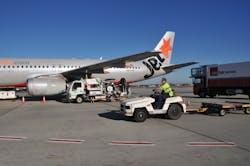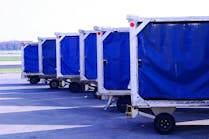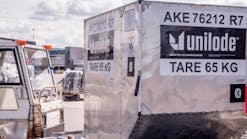To better understand The Perth Airport (PER), a geography lesson is in order: PER is located 12 kilometers (7 miles) outside its namesake city, the capital of the state of Western Australia, which occupies a third of the Australian continent. It’s the country’s largest state covering 2.6 square kilometers (1 million square miles), but only about 10 percent of the country’s population lives there with 85 percent of these folks clustered in the southwest corner of the state.
Like most airports, traffic figures and development closely track the local economy. PER is a textbook example. PER currently handles 11.5 million passengers a year – double the number of passengers over the past six years. Its recent annual growth rate of passenger traffic has made it the fastest growing capital city airport in the country.
How to explain the growth? Under all that sparsely populated land are some the planet’s richest caches of mineral and energy deposits.
The airport is the commercial hub for this natural resources sector that drives the whole Australian dynamic. In turn, these resources also help fuel the Chinese and Indian manufacturing spectacular.
All that business excitement has filled the International Terminal with a steady flow of premium passengers heading to do their deals, link into the financial growth and report on investments. Airlines such as Emirates; Qatar Airways; Royal Brunei Airlines; and China Eastern Airlines are lined up at international gates with Qantas, South African Airways, Singapore Airlines, Thai Airways International and Malaysia Airlines.
Meanwhile, Jetstar, the Qantas low-cost subsidiary, is also gearing up to win a slice of the traffic in both the international and domestic markets.
REGIONAL POWERHOUSE
But the more interesting story is how the aviation industry has stepped up to supply manpower, provisions and equipment to remote mining sites and ports throughout Western Australia.
What’s referred to in Australia as “fly in/fly out” (FIFO) is big business for PER. FIFO workers typically “fly in” to a work site for a long shift of five or 10 days and, then, “fly out” back to their homes and families for rest and relaxation before doing it over again.
Currently, PER totals for domestic passenger traffic is 8.2 million compared to 3.7 million at the turn of the new century. That number includes more than FIFO passengers, but around 60 percent of all aircraft movements through PER to and from destinations within Australia are to Western Australia. Just under half of these are scheduled flights and the remainder are charter and general aviation flights.
It’s hard to imagine how the country’s natural resources sector could have been fully developed without aviation service from PER:
- Approximately three-quarters of all PER’s “intrastate” passenger movements are related to the resource sector. Intrastate aviation encompasses airline and general aviation activities within a state or territory.
- The number of intrastate passengers using PER during the past five years has jumped by 90 percent.
- The Perth-Karratha route is PER’s fourth busiest, with as many as 10 flights each day. (Karratha is a major source of iron ore and the site of the country’s biggest natural gas operation.)
- PER now acts as a base for flights to more than 54 regional ports directly related to the natural resources sector across Western Australia,.
- BHP Billiton, considered the world’s largest mining company, and The Rio Tinto Group, a multinational mining and natural resources excavator, both have established training sites and other administrative functions directly at PER. Other natural resources sector companies are expected to follow suit.
Perth is clearly the region’s go-to hub for FIFO. Although most of the workforce is based in Perth, with a population of 1.6 million people, an increasing percentage of skilled trades and service providers come in by air from other parts of the country on regular domestic flights and then transfer to FIFO flights. These flights are not short transfers; they are long, slow sectors of up to 1,000 kilometers (620 miles) up the West Coast or inland.
There are currently seven airlines operating intrastate services from PER to points throughout Western Australia.
Qantas, for example, has 25 Bombardier Q400s, 16 Q300s and five Q200s in service alone. The existing B717 Qantas fleet is 11 aircraft with three more Q400s and another two B717s to be added in the near future. Qantas uses this fleet on more than 2,000 flights a week to 54 destinations in Western Australia.
Several other airlines combine FIFO contracts with their regional services. For example, Skywest Airlines; Skippers Aviation; Alliance Airlines; and Maroomba Airlines are established names that have been around and grown with the natural resources boom.
In a couple of cases, these airlines helped create the boom providing survey and aerial services that brought in the exploration infrastructure to determine the extent of the area’s buried treasure.
Meanwhile, smaller airlines and air charter companies have long-term contracts with the mining industry, operating mixed fleets carrying 70-100 passengers with the range they need given the distances involved. Fokker 100s, 70s and 50s, for example, are well represented, and ATR 72s, the Bombardier Dash 8 series and Embraer Brasilia are all also about the right specifications.
GROUND SERVICES
They all require ground services at the hub in Perth that makes for a very busy operation. Currently, most of the FIFO carriers operate from a cluster of small satellite terminals around the airport.
Plans are under way, however, to consolidate the whole regional and FIFO operations into a new dedicated terminal with its own ground support service facility. Just last August, PER broke ground on a new $120 million Australian dollar ($117 million) terminal designed to meet the needs of air services for Western Australia, particularly for the natural resources sector.
The new terminal will have the space to cater to up to 36 aircraft and include more check-in counters, a larger security screening zone, access to 14 gates via covered walkways and easier access to parking and transportation for arriving and departing passengers.
This development should make life a whole lot simpler for the ground support staff. Perth has an exceptional amount of vehicle traffic on the airside. It is a large site that requires the ground service operators to travel between the Domestic and International terminals located 11 kilometers (6 miles) apart and on opposite sides of the operational runways and taxiway system to a separate GA base, maintenance area and regional charter apron where most of the FIFO activity happens.
Traffic management is a real issue. With long days, sunrise and sunset are subject to extreme visual glare for the drivers and pilots. Driving into the sun accounts for the majority of near misses and incidents where situational awareness is compromised due to the angle of the sun.
There are four live taxiway crossings involved, which makes driver training a particularly important issue. Mixing aircraft and moving ground equipment is never ideal. Add to that equation, pedestrian passengers on the apron. Aerobridges work well on larger aircraft, but with the number of commuter aircraft involved, the streams of passengers making it to and from the terminals keep the workforce on high alert.
Airport Safety Manager Darren McKenzie and staff juggle the safety operations. McKenzie knows the problems and has the respect of the ground service operators, airlines and other service providers to make decisions and create a safe environment.
“I know it comes down to individual tasks,” McKenzie says, “but the more connected everyone is on, say, a turnaround the better. If you know that it is essential that the caterers, for example, can get through and park at the aircraft door or that the fuel supplier has room to safely lay out a hose, then there is less stress on the apron. It comes down to communications and having the knowledge and the awareness of what the other team members are all about.”
Construction of the new terminal is the first part of a $700 million Australian dollar ($684 million) expansion for PER. The first stage of the redevelopment will also include the following:
- Significantly expanding the International Terminal, including facilities for A380 aircraft.
- Adding a shared domestic/international pier to the International Terminal. The pier will allow airlines to swing aircraft between domestic and international markets.
- Providing more aircraft parking and taxiways.
- Investing in roads and parking to provide better access to and from the airport.
In addition, PER runs practically around the clock. Although PER operates under restrictions on the use of certain runways at night, a large proportion of PER’s domestic and international air services occur during the night due to PER’s location relative to the East Coast of Australia, as well as important overseas markets.
Many of PER’s international services, for example, must connect to other services into Europe via hub airports in Asia and Middle East.
The multimillion dollar improvements are expected to take three years to complete. The airport, airlines and ground support services all linked with the natural resources sector and the Australian and global economy – in what looks like a very busy and productive future.
Perth will feel a lot less isolated and more mainstream in the years ahead.
About the author: Steve Bowman heads a new media company producing online training products for the aviation and transportation industry. For more information, log on to [email protected].






